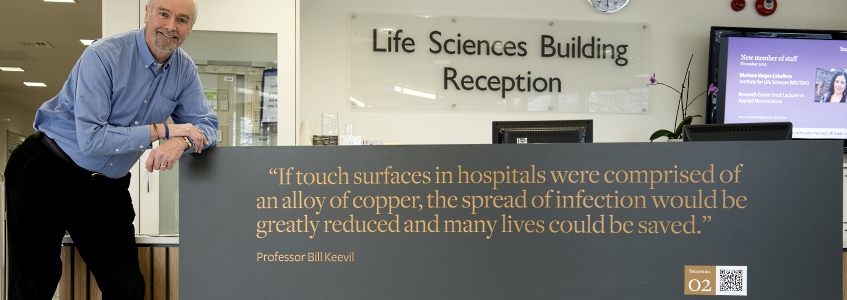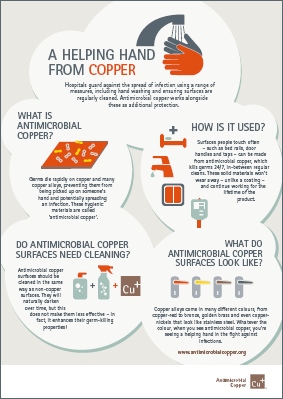According to the World Health Organization, patient safety is a serious global public health issue, and the biggest problem is healthcare-associated infections, which affect hundreds of millions of patients worldwide every year. The strategic deployment of antimicrobial copper high-touch components can help to reduce the spread of HCAIs and lower the risk of patients acquiring an infection.
Estimates show that, in developed countries, as many as one in 10 patients is harmed while receiving hospital care. In these countries, seven out of every hundred hospitalised patients at any given time will acquire healthcare-associated infections (HCAIs). In developing countries, the number is even higher, with ten out of every hundred patients developing an HCAI.
Hospitals around the world are implementing measures to tackle the problem, including hand hygiene programmes, patient isolation and antimicrobial prescribing. While these programmes are helping to reduce the problem, more can be done and the use of an effective antimicrobial material like antimicrobial copper provides an additional measure to boost infection control and help prevent the spread of infection.
Evidence Base
There is a substantial and growing evidence base for copper's efficacy in the lab and the clinical environment (see Scientific References), which can be summarised by these main points and key references (see footer):
- Antimicrobial copper has been shown to reduce bacterial burden.1, 2, 3, 4, 5, 6, 7
- Reducing bacterial burden has resulted in reduced rates of healthcare-associated infections, for patients treated in Intensive Care Unit rooms with antimicrobial copper touch surfaces.8
- The deployment of antimicrobial copper surfaces represents the first instance where a continuously active antimicrobial material was able to significantly reduce the rate at which infections were contracted by hospitalised patients.
- Incorporation of copper into essential items within the built environment of hospitals offers a unique solution to control and limit HCAIs in an efficient and cost-effective manner.9, 10, 11

Informing Patient Safety Bodies about Copper's Role in Infection Control
At a Risk Prevention and Patient Safety workshop in Paris, Professor Bill Keevil – a leading expert in environmental health – delivered a keynote presentation on the risk presented to patients by hospital pathogens, and the role copper can play in tackling these and improving patient safety.
The French patient organisation, Le Lien – representing victims of HCAIs and medical accidents – and the World Health Organization's Patients for Patient Safety Initiative – a programme that brings together patients, providers and policy-makers dedicated to improving healthcare safety through advocacy, collaboration and partnership – held a joint workshop in Paris to discuss the issue of HCAIs and actions, addressing an audience of policy-makers, healthcare professionals and industry representatives, family members and patients.
Professor Keevil, Chair of Environmental Healthcare at the University of Southampton, presented research on copper's efficacy against hospital pathogens such as MRSA and norovirus, and the role of copper touch surfaces as an additional infection control measure. He also covered follow-on work by clinical trial groups showing antimicrobial copper surfaces continuously reduce contamination by >80%, and a multi-centre clinical trial in the US that further showed these surfaces reduced an ICU patient's risk of acquiring an HCAI by 58%.
'Given the huge number of patients affected, globally, by healthcare-associated infections, healthcare facilities need to do all they can to prevent their spread,' explains Professor Keevil. 'Solid copper and copper alloy touch surfaces offer an additional line of defence, working to support key infection control measures such as frequent hand washing and regular surface cleaning and disinfection.'
Other speakers – from Rambouillet Hospital, North Parisian Private Hospital and Arago Clinic – discussed their experiences with replacing frequently-touched surfaces such as door handles, taps and hand rails with solid antimicrobial copper equivalents, providing a healthier environment for patients. ICUs and orthopaedic facilities were highlighted as having a high potential for the spread of HCAIs and thus priority targets for equipment with antimicrobial copper touch surfaces.
To visit the Patient for Patient Safety section of the World Health Organisation's website, click here. Details of country initiatives are provided with the Le Lien/WHO event under 'France'. To view the workshop report (Prof Keevil's presentation 'Break the chain of infection' is summarised on pages 26-30), click here (or download it from the bottom of this page). For an overview of the event and its participants, click here to watch a short video.
Following the Paris event, Professor Keevil presented at Patient First in London, an event aimed at improving patient safety across the NHS and independent healthcare organisations. His presentation was titled 'Infection Reduction – The Case for Copper'.
If you would like to request a speaker for your organisation to present on copper's role in improving patient safety, please complete the enquiry form.
Information for Patients
Copper Alliance has produced a simple guide to Antimicrobial Copper for patients to explain what it does, what it looks like and how it works as a supplement to standard practices, not as a substitute. The poster can be used for Patient Focus Groups and in a hospital where copper has been installed. Click the link below to download a copy.

References
- Antimicrobial efficacy of copper touch surfaces in reducing environmental bioburden in a South African community healthcare facility. Marais F et al, J Hosp Infect (2009), doi:10.1016/j.jhin.2009.07.010.
- Role of Copper in Reducing Hospital Environment Contamination. A L Casey, D Adams, T J Karpanen, P A Lambert, B D Cookson, P Nightingale, L Miruszenko, R Shillam, P Christian and T S J Elliott, J Hosp Infect (2009), doi:10.1016/j.jhin.2009.08.018.
- The Antimicrobial Efficacy of Copper Alloy Furnishing in the Clinical Environment; a Cross-over Study. Karpanen T J, Casey A L, Lambert P A, Cookson B D, Nightingale P, Miruszenko L and Elliott T S J. Infection Control and Hospital Epidemiology (2012).
- Evaluation of Antimicrobial Properties of Copper Surfaces in an Outpatient Infectious Disease Practice. Seema Rai, Bruce E Hirsch, Hubert H Attaway, Richard Nadan, S Fairey, J Hardy, G Miller, Donna Armellino, Wilton R Moran, Peter Sharpe, Adam Estelle, J H Michel, Harold T Michels and Michael G Schmidt. Infect Control Hosp Epidemiol. 2012 Feb
- Application of copper to prevent and control infection. Where are we now? O’Gorman J, Humphreys H, Journal of Hospital Infection (2012).
- Copper Continuously Limits the Concentration of Bacteria Resident on Bed Rails within the Intensive Care Unit. Michael G Schmidt, PhD; Hubert H Attaway III, MS; Sarah E Fairey, BS; Lisa L Steed, PhD; Harold T Michels, PhD; Cassandra D Salgado, MD, MS. Infection Control and Hospital Epidemiology, Vol. 34, No. 5. Special Topic Issue: The Role of the Environment in Infection Prevention (May 2013), pp. 530-533.
-
Copper Surfaces are Associated with Significantly Lower Concentrations of Bacteria on Selected Surfaces within a Pediatric Intensive Care Unit. Michael G. Schmidt PhD; Bettina von Dessauer MD; Carmen Benavente MD; Dona Benadof MD; Paulina Cifuentes RN; Alicia Elgueta RN; Claudia Duran MS; Maria S. Navarrete MD MPH. American Journal of Infection Control, doi:10.1016/j.ajic.2015.09.
-
Copper Surfaces Reduce the Rate of Healthcare-Acquired Infections in the Intensive Care Unit. Cassandra D Salgado, MD; Kent A Sepkowitz, MD; Joseph F John, MD; J Robert Cantey, MD; Hubert H Attaway, MS; Katherine D Freeman, DrPH; Peter A Sharpe, MBA; Harold T Michels, PhD; Michael G Schmidt, PhD. Infection Control and Hospital Epidemiology.
-
The Economic Assessment of an Environmental Intervention: Discrete Deployment of Copper for Infection Control in ICUs. M Taylor, S Chaplin, York Health Economics Consortium, York, UK, Antimicrobial Resistance and Infection Control 2013, 2(Suppl1):P368.
-
Financial Benefits after the Implementation of Antimicrobial Copper in Intensive Care Units (ICUs). P Efstathiou, E Kouskouni, S Papanikolaou, K Karageorgou, Z Manolidou, M Tseroni, E Logothetis, C Petropoulou, V Karyoti. Antimicrobial Resistance and Infection Control 2013, 2(Suppl 1):P369.
-
From Laboratory Research to a Clinical Trial: Copper Alloy Surfaces Kill Bacteria and Reduce Hospital-Acquired Infections. Michels, H.T. 2015. Health Environments Research & Design Journal. 1–16.

